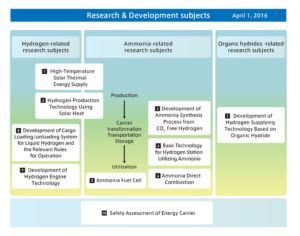Japanese Cabinet Office Holds Energy Carriers Symposium
By Stephen H. Crolius on August 24, 2017
Ammonia energy received favorable notice at the Energy Carriers “Open Symposium” held on July 26 by the Cabinet Office of the Japan Government. Hydrogen energy carriers are a key focus of Japan’s Cross-Ministerial Strategic Innovation Promotion Program. The event took place at Hitotsubashi University in Tokyo. An observer estimated that approximately 400 attendees were present.

According to its strategy statement, the Energy Carriers program has been focused since its 2014 inception on “technology development . . . toward the realization of hydrogen society,” and since April 2016 on ten “research and development subjects.” The program is led by Shigeru Muraki, Executive Advisor to Tokyo Gas Company.
According to a press release from the Japan Science and Technology Agency (JST), Muraki indicated in his remarks that the Energy Carriers program had made “significant progress on technology.” He then added, “especially using ammonia as fuel directly.” He went on to observe that “direct use of ammonia is promising for hydrogen cost and hydrogen power generation cost.” This observation may reflect an emerging sense within the Energy Carriers program that ammonia is pulling ahead of its energy carrier rivals, liquid hydrogen and organic hydrides. Neither of these alternatives was mentioned in the JST press release.
Muraki was followed on the Symposium program by Takao Kashiwagi, Professor Emeritus of Tokyo Institute of Technology, who spoke about Japanese energy strategy and the “National Energy and Environment Strategy for Technological Innovation towards 2050” (NESTI 2050). The intention to develop NESTI 2050 was announced by Japan’s Prime Minister Shinzo Abe in November 2015 at the United Nations Climate Change Conference (COP 21) in Paris. The Strategy is intended to promote “innovations that will dramatically reduce greenhouse gases on a global basis.” Its role is to “identify technologies that should be targeted for more focused, intensive research and development activities, to discuss the technological issues to be overcome, and to outline the systems under which research and development activities should be pursued. At the same time, this strategy is designed to describe the measures by which Japan will contribute to the world.”
The NESTI 2050 report touches on all of the SIP energy carriers but devotes the most attention to ammonia. It mentions innovative ammonia synthesis; hydrogen extraction from ammonia; control of ammonia combustion; and the need for research into ammonia safety.
The international implications of Japan’s hydrogen society work have appeared as a theme in a number of recent contexts. Muraki, too, brought it in his remarks, saying that the Program is “actively working toward international development, such as holding lectures at international conferences and holding workshops with each country.” The theme can be seen from a different angle in the JST’s announcement of the Green Ammonia Consortium. In listing the Consortium’s goals, the press release mentions a strategy that, among other things, will enable “Japanese industry to lead the world market.”
The bulk of the Symposium was taken up by papers on “the results so far” delivered by research managers of the ten R&D subjects that comprise the focus of the Energy Carriers work. These include “model demonstration machines, large prototype production, and test driving in real machines.”
The Symposium was brought to a close by Junko Shiraki of the JST. Shiraki promised on-going cooperation among government agencies, industry, and academia, and to “continue to develop technologies with international collaboration in mind.”